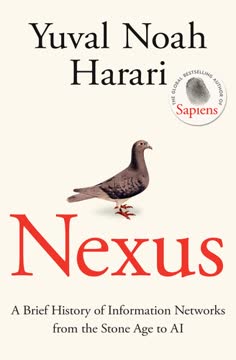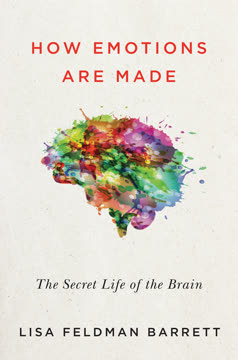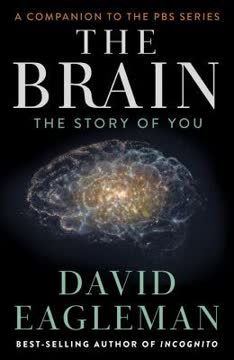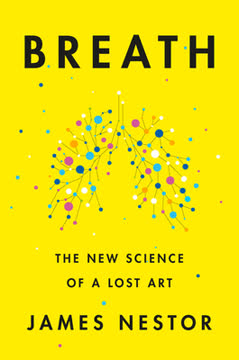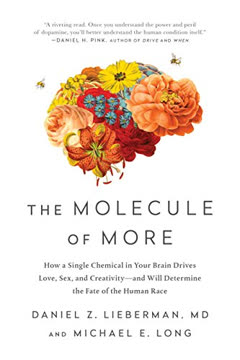重点摘要
1. 多巴胺驱动渴望,推动我们不断追求“更多”
多巴胺并不具备良知,它是一种由渴望驱动的狡黠力量。
多巴胺渴望回路的进化,旨在促进有助于生存和繁衍的行为。它制造出想要和期待的感觉,激励我们去寻找食物、性以及其他资源。然而,多巴胺代表的是“想要”,而非“喜欢”。它带来一种永远无法完全满足的期待感,始终推动我们渴望更多。
多巴胺在动机中的作用包括:
- 遇到潜在奖励刺激时,激发渴望和兴奋感
- 将注意力聚焦于未来可能性,而非当前体验
- 在遇到意外奖励时产生“奖励预测误差”,强化寻求奖励的行为
- 即使客观满足,也驱使我们追求新奇和变化
这种对“更多”的不断追求,在资源匮乏的环境中帮助了我们的祖先。然而,在现代的丰富环境中,它可能导致焦躁不安、成瘾以及无法珍惜现有的困境。
2. 爱情从激情转向伴侣情感,源于神经化学的变化
人类学家海伦·费舍尔指出,早期的“激情”爱情通常只持续十二到十八个月。
爱情的化学成分随着关系的发展而变化。早期的激情爱情由多巴胺驱动,带来强烈的专注、能量和欣快感。这种多巴胺驱动的状态促使寻找伴侣和建立联系,但并不具备长期维持的能力。
爱情阶段及其神经化学基础:
- 激情爱情:由多巴胺和去甲肾上腺素驱动,产生兴奋和痴迷的专注
- 伴侣爱情:由催产素、加压素和内啡肽介导,促进亲密和满足感
- 转变期:多巴胺水平回归正常,常伴随失望感
为了让关系持久,伴侣双方必须成功完成从多巴胺驱动的激情向更稳定的催产素和加压素介导的伴侣爱情的转变。这一转变带来更深层的情感连接和长期满足,尽管缺少早期浪漫的强烈“高潮”。
3. 成瘾劫持大脑奖励系统,压倒理性决策
屈服于渴望并不一定带来快乐,因为“想要”与“喜欢”是不同的。多巴胺许下的承诺往往无法兑现。
成瘾的神经基础在于多巴胺能够制造强烈的渴望,即使没有快乐感。成瘾物质和行为释放的多巴胺远超自然奖励,形成渴望与失望的恶性循环。
成瘾的关键特征:
- 劫持大脑的自然奖励系统
- 造成“想要”与“喜欢”的脱节
- 导致耐受性,需要越来越强的刺激才能达到同样效果
- 损害前额叶皮层,削弱冲动控制和决策能力
- 常与心理健康问题共存,因神经脆弱性相似
认知行为疗法、动机增强疗法和十二步计划等治疗方法,通过激活不同脑回路来对抗成瘾行为,旨在强化冲动控制、建立改变动机并创造支持性的社会结构。
4. 创造力与精神疾病共享多巴胺根源
创造力是将看似无关的事物联系起来的能力。
创造力与精神疾病之间的多巴胺联系,解释了为何高度有创造力的人常伴随情绪障碍或精神病。创造力和某些精神疾病都涉及多巴胺活动增强,这既能带来新颖的联系和想法,也可能导致思维紊乱。
创造性/精神病思维的特点:
- 低潜抑制:难以过滤无关刺激
- 发散性思维:能产生多样且独特的想法
- 增强的模式识别:发现他人忽视的联系
- 强烈的专注和动机:执着追求创造目标
- 情绪敏感性:对体验反应强烈
这解释了为何艺术家和创新者的高创造力时期常与抑郁或躁狂交替出现。虽然并非所有创造者都有精神疾病,反之亦然,但理解这一联系有助于管理创造性气质并支持双相障碍或精神分裂症患者。
5. 政治意识形态反映多巴胺与催产素/加压素神经递质的差异
自由派常自称进步派,意味着不断改进。进步派拥抱变化。
政治观点的神经化学基础显示,自由派倾向于多巴胺活动较高,而保守派则受催产素和加压素影响更大。这种差异体现在对社会和政治问题的不同态度上。
自由派与保守派的神经化学倾向:
- 自由派:多巴胺活动较高
- 更开放于变化和新奇
- 关注未来可能性和进步
- 抽象且宏观的思维方式
- 保守派:催产素和加压素影响更强
- 偏好稳定和传统
- 关注眼前具体问题
- 重视人际关系和地方社区
这些倾向影响政策偏好,自由派更支持大规模政府项目和社会变革,保守派则倾向维护传统结构和个人责任。理解这些神经化学差异,有助于增进同理心和促进更有效的政治对话。
6. 多巴胺推动人类进步,但也带来环境与社会风险
作为一个物种,我们比大脑初步形成时强大得多。技术发展迅速,而进化缓慢。
多巴胺驱动的进步是一把双刃剑,带来了卓越的科技和社会进步,同时也引发了前所未有的全球挑战。我们对“更多”的追求推动创新,却可能导致环境破坏、社会动荡及潜在的生存风险。
多巴胺在人类进步与风险中的作用:
- 促进科学发现和技术创新
- 推动经济增长和物质丰富
- 激励探索和知识扩展
- 导致过度消费和环境退化
- 可能加剧社会不平等和文化冲突
- 通过人工智能和基因工程等先进技术带来风险
平衡多巴胺驱动的进步与其潜在危害,是人类面临的重大挑战。需要建立新的社会、政治和技术体系,既能利用创新动力,又能减轻负面影响。
7. 平衡多巴胺与催产素/加压素是实现满足与幸福的关键
要过上美好生活,我们需要让它们重新达到平衡。
实现多巴胺与催产素/加压素系统的神经化学和谐,对个人幸福和社会福祉至关重要。这种平衡使我们既能追求目标和成长,也能珍惜当下体验并维系有意义的人际关系。
平衡多巴胺与催产素/加压素活动的策略:
- 正念练习:增强对当下体验的觉察
- 感恩练习:提升对现有的珍惜
- 设定目标并反思:结合未来导向的行动与当下满足
- 培养关系:通过社交联结激活催产素/加压素系统
- 追求精通:在技能发展和能力提升中找到满足
- 新奇与常规交替:平衡兴奋与稳定
- 亲近自然:参与感官体验和自然节律
通过有意识地培养这种平衡,个体能体验更深的满足感、韧性和整体生活幸福感。在社会层面,促进这种平衡有助于实现更可持续的进步和更健康的社区。
最后更新日期:
FAQ
What's The Molecule of More about?
- Focus on Dopamine: The book explores dopamine's role in driving human behavior, emotions, and creativity, influencing desires, motivations, and relationships.
- Connection to Human Experience: It links dopamine to love, addiction, creativity, and politics, showing how this molecule shapes our lives.
- Scientific Insights: Authors Daniel Z. Lieberman and Michael E. Long use scientific research to explain dopamine's complex effects on our lives.
Why should I read The Molecule of More?
- Understanding Human Behavior: Gain insights into why we desire what we don’t have and how it affects happiness and relationships.
- Practical Applications: Apply knowledge to improve relationships, manage addictions, and enhance creativity.
- Engaging Narrative: The authors present scientific concepts in an accessible manner, appealing to both science enthusiasts and general readers.
What are the key takeaways of The Molecule of More?
- Dopamine Drives Desire: Dopamine is about desire and anticipation, motivating us to seek new experiences and rewards.
- Love Evolves Over Time: Relationships transition from dopamine-driven passion to companionate love, requiring adaptation.
- Addiction and Control: Balancing desire with control is crucial for long-term well-being, as dopamine can lead to addiction.
How does dopamine affect love and relationships in The Molecule of More?
- Initial Passion: Dopamine fuels intense attraction and desire at the start of relationships.
- Fading Connection: As novelty fades, dopamine-driven passion can diminish, leading to a stable but less intense love.
- Transition to Companionate Love: Successful relationships shift to H&N neurotransmitters, promoting satisfaction and emotional connection.
What role does dopamine play in addiction according to The Molecule of More?
- Desire Over Pleasure: Dopamine drives the desire for substances, leading to compulsive behavior despite negative consequences.
- Impact on Decision-Making: Addiction alters the brain's reward system, making it hard to resist cravings.
- Treatment Insights: Understanding dopamine's role can inform treatment strategies addressing both desire and underlying emotional issues.
How does The Molecule of More explain creativity and madness?
- Link to Dopamine: Heightened dopamine activity is associated with creative thinking and mental health disorders.
- Creative Minds: High dopamine levels can lead to creativity but also mental health challenges.
- Understanding Risks: The book provides insights into harnessing creativity while managing risks of high dopamine levels.
What is the significance of the "Here & Now" (H&N) neurotransmitters in The Molecule of More?
- Present-Focused Experience: H&N neurotransmitters, like serotonin and oxytocin, are responsible for enjoying present experiences.
- Balancing Dopamine: Balancing dopamine-driven desires with H&N experiences is crucial for long-term happiness.
- Role in Companionate Love: H&N neurotransmitters facilitate the transition to a deeper, stable form of love.
How does The Molecule of More address the concept of self-control?
- Willpower as a Resource: Willpower is a limited resource that can deplete, leading to impulsive decisions.
- Strategies for Improvement: Self-control can be strengthened through cognitive behavioral therapy and motivational enhancement therapy.
- Importance of Environment: Managing environmental cues can improve self-control and lead to healthier choices.
What is the significance of low latent inhibition discussed in The Molecule of More?
- Definition of Low Latent Inhibition: It refers to a reduced ability to filter out irrelevant stimuli, leading to heightened awareness.
- Connection to Creativity: Individuals with low latent inhibition may excel in creative fields due to unique insights.
- Risks Involved: While enhancing creativity, it can also contribute to mental health issues like schizophrenia.
How does The Molecule of More relate dopamine to creativity?
- Dopamine as a Creative Driver: Dopamine fuels the creative process by encouraging exploration and novel ideas.
- Link to Mental Illness: High dopamine levels can lead to creative breakthroughs and mental health challenges.
- Practical Implications: Understanding this relationship helps harness creativity while being mindful of risks.
How does the book address the impact of technology on dopamine levels?
- Technology as a Dopamine Amplifier: Modern technology, especially social media, can exacerbate dopamine-driven behaviors.
- Virtual Reality's Allure: Virtual reality provides intense dopamine stimulation, potentially reducing real-world interactions.
- Need for Moderation: Balancing technology use with real-life connections is emphasized for well-being.
What are the implications of dopamine-driven behavior for society, as discussed in The Molecule of More?
- Political Ideologies: Dopamine influences political beliefs, with liberals often embodying change-oriented mindsets.
- Environmental Challenges: Unchecked dopamine-driven consumption could lead to environmental degradation.
- Call for Awareness: The book encourages mindfulness of dopamine-driven desires to foster a healthier society.
评论
《多巴胺分子》广受好评,因其生动地探讨了多巴胺在人类行为中的作用。读者们赞赏书中对复杂神经科学的通俗解释,以及其对爱情、政治等生活各方面的深刻见解。尽管有人批评内容过于简化、科学严谨性不足,但也有读者认为本书令人耳目一新,具有变革性。书中对多巴胺如何影响动机、创造力和决策的分析获得广泛赞誉,然而对于某些观点的深度和可信度,尤其是后半部分章节,评价则存在分歧。
Similar Books


